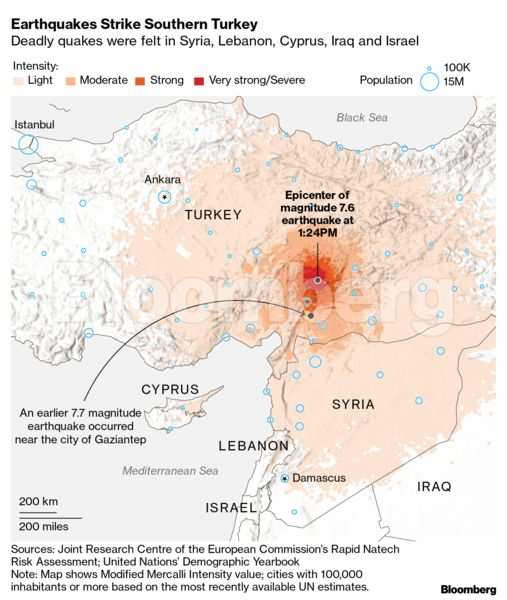Mexico stunned markets by increasing rates by half a percentage point to a record 11%, in a move by the central bank to outpace the Federal Reserve that no top economist projected. Officials in Iceland accelerated monetary tightening, adding a half-point hike to what is already western Europe’s highest interest rate.
Policymakers in Australia were also quite hawkish, with the central bank boosting its forecast for core inflation this year as it tries to ensure the economy avoids a wage-price spiral.
Here are some of the charts that appeared on Bloomberg this week on the latest developments in the global economy:
World
 Bloomberg
BloombergIndia’s central bank slowed the pace of its repurchase-rate hike to 25 basis points, but hopes of a pause dashed after Governor Shaktikanta Das said a change in the current stance would need a decisive moderation in prices. Officials in Sweden and Serbia hiked rates, while those in Poland, Uganda, Romania, Russia and Peru stood pat.
Europe
 Bloomberg
BloombergThe UK avoided a recession last year by the narrowest of margins. Gross domestic product was unchanged in the fourth quarter following a revised 0.2% decline in the previous three months. The economy was still 0.8% smaller than it was at the end of 2019, making the UK the only Group of Seven country that has yet to fully recover output lost during the pandemic.German factory orders grew more than anticipated in December in the latest sign that Europe’s largest economy will get through the winter without seeing a slump.
 Bloomberg
BloombergAsia
 Bloomberg
BloombergJapanese workers’ nominal wages in December rose at the fastest pace since 1997, an acceleration in gains that may fuel speculation the central bank will consider shifting policy after Governor Haruhiko Kuroda steps down in April.
 Bloomberg
BloombergChina’s consumer inflation accelerated last month as the country reopened and the Lunar New Year holiday spurred demand, although gains remain muted enough for the central bank to keep easing monetary policy to support the economy’s recovery.
US
 Bloomberg
BloombergThe US trade deficit widened to a record last year on a surge in imports as American companies scrambled early on to ensure they had enough merchandise on hand to meet demand. This year, however, global trade is expected to decelerate after central banks aggressively raised interest rates to combat an inflation surge owed in part to strong demand.
 Bloomberg
BloombergDon’t count the US consumer out just yet. Two sets of data out Friday raised hopes that the pullback in household spending at the end of last year was just a blip. In the first month of 2023, Americans ramped up purchases of services — everything from restaurant meals to health care — while businesses went on a surprise hiring spree.
 Bloomberg
BloombergTalks for a new labor pact between West Coast dockworkers and their employers are stretching into a 10th month, but with no agreement in sight and volumes dropping, patience is wearing thin. A volume slowdown is lowering urgency on the new deal for 22,000 dockworkers, according to people working in the logistics industry. Shipping costs have also plunged.
Emerging Markets
 Bloomberg
BloombergA daunting economic landscape will exacerbate the humanitarian catastrophe wrought by a pair of earthquakes on Turkey, as early estimates of the damage point to mounting inflation and budget risks on the nation’s $819 billion economy. Public spending may be equivalent to 5.5% of GDP, according to an initial estimate from Bloomberg Economics.
 Bloomberg
BloombergChile’s consumer prices rose well above forecast in January, just as the central bank was turning more hawkish, conditioning eventual interest-rate cuts on stronger evidence that inflation is easing toward target.









